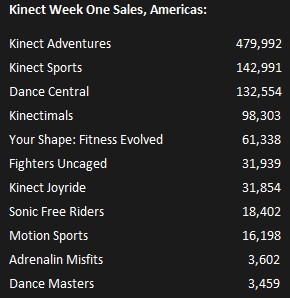 Claims that the Microsoft’s Kinect would outdo the success of the Playstation Move could be right. Even as Sony was celebrating its inability to keep its new motion gaming device on shelves, analysts were calling the company’s triumph premature. Only once its direct competitor, the Kinect, was released, could Move’s real market success be defined.
Claims that the Microsoft’s Kinect would outdo the success of the Playstation Move could be right. Even as Sony was celebrating its inability to keep its new motion gaming device on shelves, analysts were calling the company’s triumph premature. Only once its direct competitor, the Kinect, was released, could Move’s real market success be defined.
One research firm in particular gave Kinect the benefit of the doubt, assuming the hands-free device would sell about a quarter of a million more units than Move by the year’s end. Today, VGChartz released some numbers reaffirming that approximation. According to VGChartz’s numbers, the Kinect sold twice as well as Move did in its first week, to the tune of 475,000 units.
Given that Microsoft allegedly invested $500 million in the Kinect marketing campaign, it isn’t incredibly surprising it’s currently outselling Move. Shortly before its launch, Microsoft executive Aaron Greenburg claimed this was the “largest launch we’ve ever had as a business.” Bold words, right? It looks like Microsoft might be exaggerating a few things. Executives and developers have been tweeting furiously for the last week about the Kinect’s takeover, emphasizing that you better get your hands on one now, before it’s too late! But this all might be for effect, as there are claims its less due to consumer demand than Microsoft’s own product shortages keeping the Kinect off shelves.
Regardless of whether or not Microsoft is embellishing, the early speculation of it outselling Move remains. Still, keep in mind both these products were very recently released, and holiday shopping is just gearing up. The end of the quarter should reveal a concrete winner.
Editors' Recommendations
- Xbox Series X vs. PS5: Which should you buy in 2024?
- Is Baldur’s Gate 3 coming to Xbox?
- Baldur’s Gate 3 and Hades have made me an early access believer
- Your Xbox Live Gold subscription will turn into Xbox Game Pass Core this September
- We ranked all the best (and worst) video game system startup sounds


